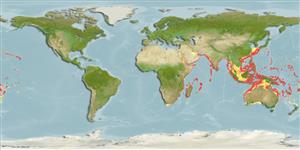Common names from other countries
Environment: milieu / climate zone / depth range / distribution range
Ekologi
marina revassocierade; djupintervall 1 - 650 m (Ref. 34024), usually 180 - 220 m (Ref. 37816). Tropical; 33°N - 38°S, 17°E - 155°W (Ref. 34024)
Indo-Pacific: Red Sea and East Africa to Pitcairn, north to southern Japan, south to Lord Howe Island. Also reported from Persian Gulf (Ref. 68964).
Size / Vikt / Age
Maturity: Lm ? range ? - ? cm
Max length : 100.0 cm TL hane/ej könsbestämd; (Ref. 5213); common length : 30.0 cm TL hane/ej könsbestämd; (Ref. 9987)
Short description
Bestämningsnycklar | Morfologi | Morfometri
Taggstrålar i ryggfenan (totalt) : 0; Mjukstrålar i ryggfenan (totalt) : 109 - 139; Taggstrålar i analfenan: 0; Mjukstrålar i analfenan: 80 - 106. In addition to meristic counts, B. multibarbata differs from B. townsendi by possessing a larger eye (width>interorbital space) and having slightly different coloration (dark brown with a submarginal black band and narrow white border on the dorsal and anal fins versus greenish to orange brown with orange-bordered dorsal and anal fins).
Benthopelagic on shelf and upper slope (Ref. 34024). Larvae found in the epipelagic far offshore (Ref. 34024). Found in shallow lagoon and seaward reefs and occurs at depths of at least 220 m. Adults (30-90 cm) move to depths of 100-650 m (Ref. 58472). A nocturnal species, rarely seen for it lives in caves and crevices during the day and periodically emerges from cover at night to feed on crustaceans, mainly crabs, and fishes. Oviparous, with oval pelagic eggs floating in a gelatinous mass (Ref. 205). Utilized fresh and eaten steamed, pan-fried and baked (Ref. 9987). Also Ref. 58302.
Life cycle and mating behavior
Maturities | Reproduktion | Spawnings | Egg(s) | Fecundities | Larver
Nielsen, J.G., D.M. Cohen, D.F. Markle and C.R. Robins, 1999. Ophidiiform fishes of the world (Order Ophidiiformes). An annotated and illustrated catalogue of pearlfishes, cusk-eels, brotulas and other ophidiiform fishes known to date. FAO Fish. Synop. 125(18):178p. Rome: FAO. (Ref. 34024)
IUCN Red List Status (Ref. 130435)
CITES (Ref. 128078)
Not Evaluated
Threat to humans
Harmless
Human uses
Fiskeri: mindre kommeriell; sportfisk: ja
Verktyg
Special reports
Download XML
Internet-källor
Estimates based on models
Preferred temperature (Ref.
115969): 13.4 - 23, mean 15.9 (based on 98 cells).
Phylogenetic diversity index (Ref.
82804): PD
50 = 0.5156 [Uniqueness, from 0.5 = low to 2.0 = high].
Bayesian length-weight: a=0.00380 (0.00154 - 0.00938), b=3.13 (2.91 - 3.35), in cm Total Length, based on LWR estimates for this (Sub)family-body shape (Ref.
93245).
Trofisk nivå (Ref.
69278): 3.7 ±0.5 se; based on diet studies.
Resiliens (Ref.
120179): Låg, lägsta populationsfördubblingstid 4,5-14 år (Preliminary K or Fecundity.).
Fishing Vulnerability (Ref.
59153): High vulnerability (60 of 100).
